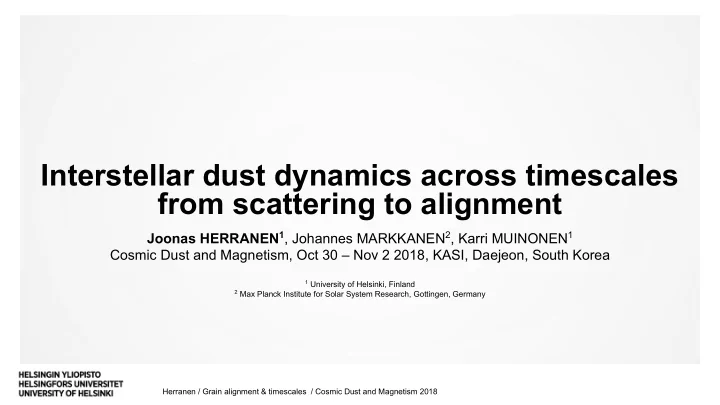

Interstellar dust dynamics across timescales from scattering to alignment Joonas HERRANEN 1 , Johannes MARKKANEN 2 , Karri MUINONEN 1 Cosmic Dust and Magnetism, Oct 30 – Nov 2 2018, KASI, Daejeon, South Korea 1 University of Helsinki, Finland 2 Max Planck Institute for Solar System Research, Gottingen, Germany Herranen / Grain alignment & timescales / Cosmic Dust and Magnetism 2018 Matemaattis-luonnontieteellinen tiedekunta
Outline of the talk 1. Scattering dynamics of arbitrary particles 2. Interstellar dust model and different timescales of alignment 3. Automatic alignment pipeline through the timescales and results Matemaattis-luonnontieteellinen tiedekunta
Scattering dynamics software v0.7 • Based on the JVIE T -matrix code by J. Markkanen • Geometries defined as tetrahedral meshes • Usually Gaussian random spheres/ellipsoids (K. Muinonen) Matemaattis-luonnontieteellinen tiedekunta
Light scattering transfers (angular) momentum → scattering dynamics Expansion of fields in terms of VSWFs Analytical form of torques (and forces) in the expansion Matemaattis-luonnontieteellinen tiedekunta
Fast scattering solution allows detailed study of rotation and motion Example: Optical tweezers Matemaattis-luonnontieteellinen tiedekunta
We pursue towards alignment via explicit and exact methods (as far as possible) A spinning body in Forces, torques , and A full solution of free space how the equations of scattering, dynamics motion are solved and polarization in a realistic interstellar environment Matemaattis-luonnontieteellinen tiedekunta
Modeling interstellar dust particles and their environment GRE = Gaussian Random Ellipsoid Core: Silicates and amorphous hydrogenated carbon (a-C:H) Mantle: Amorphous carbon (a-C) and a-C:H (older dust) Also: Incident field spectrum Matemaattis-luonnontieteellinen tiedekunta
In free space, there are two types of alignment Internal alignment = angular momentum || principal axis (major) ≈ “Am I pointing somewhere?” External alignment = angular momentum points at certain direction ≈ “Which way is up?” Matemaattis-luonnontieteellinen tiedekunta
Grain motion under radiation (internal alignment) Matemaattis-luonnontieteellinen tiedekunta
Useful parameter for identifying internal alignment Matemaattis-luonnontieteellinen tiedekunta
Radiative torques quickly stabilize q What happens to an ensemble of different shapes? Matemaattis-luonnontieteellinen tiedekunta
Internal alignment of a 0.1 μm silicate dust ensemble under ISRF Matemaattis-luonnontieteellinen tiedekunta
From internal to external alignment 1) Spin-up by radiative torques (fast) 2) Perfect internal alignment by relaxation effects (slow) 3) Gradual alignment by radiative torques (slow) Matemaattis-luonnontieteellinen tiedekunta
External alignment of the silicate ensemble Matemaattis-luonnontieteellinen tiedekunta
Adding metallic inclusions enhance alignment Increase susceptibility by 100x Matemaattis-luonnontieteellinen tiedekunta
Conclusions • Explicit integration gives insight on the internal alignment • In certain situations the described pipeline can be useful for alignment considerations (when timescales are distinct) • The full pipeline input is shape+composition, ultimate output – when the dust settles – is the Mueller matrix (for scattered polarization) Matemaattis-luonnontieteellinen tiedekunta
Recommend
More recommend